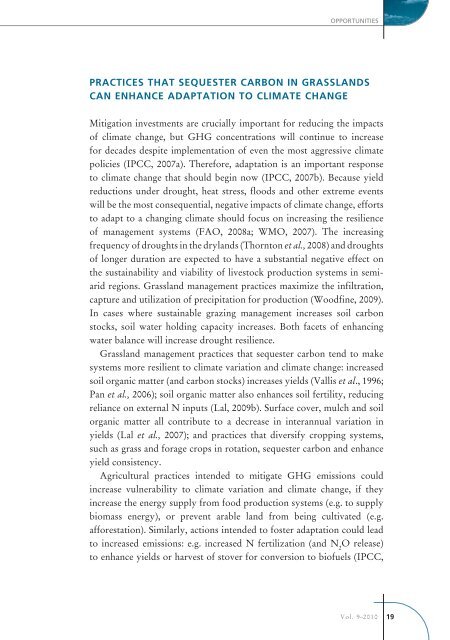Challenges and opportunities for carbon sequestration in ... - FAO
Challenges and opportunities for carbon sequestration in ... - FAO
Challenges and opportunities for carbon sequestration in ... - FAO
Create successful ePaper yourself
Turn your PDF publications into a flip-book with our unique Google optimized e-Paper software.
<strong>opportunities</strong>Practices that sequester <strong>carbon</strong> <strong>in</strong> grassl<strong>and</strong>scan enhance adaptation to climate changeMitigation <strong>in</strong>vestments are crucially important <strong>for</strong> reduc<strong>in</strong>g the impactsof climate change, but GHG concentrations will cont<strong>in</strong>ue to <strong>in</strong>crease<strong>for</strong> decades despite implementation of even the most aggressive climatepolicies (IPCC, 2007a). There<strong>for</strong>e, adaptation is an important responseto climate change that should beg<strong>in</strong> now (IPCC, 2007b). Because yieldreductions under drought, heat stress, floods <strong>and</strong> other extreme eventswill be the most consequential, negative impacts of climate change, ef<strong>for</strong>tsto adapt to a chang<strong>in</strong>g climate should focus on <strong>in</strong>creas<strong>in</strong>g the resilienceof management systems (<strong>FAO</strong>, 2008a; WMO, 2007). The <strong>in</strong>creas<strong>in</strong>gfrequency of droughts <strong>in</strong> the dryl<strong>and</strong>s (Thornton et al., 2008) <strong>and</strong> droughtsof longer duration are expected to have a substantial negative effect onthe susta<strong>in</strong>ability <strong>and</strong> viability of livestock production systems <strong>in</strong> semiaridregions. Grassl<strong>and</strong> management practices maximize the <strong>in</strong>filtration,capture <strong>and</strong> utilization of precipitation <strong>for</strong> production (Woodf<strong>in</strong>e, 2009).In cases where susta<strong>in</strong>able graz<strong>in</strong>g management <strong>in</strong>creases soil <strong>carbon</strong>stocks, soil water hold<strong>in</strong>g capacity <strong>in</strong>creases. Both facets of enhanc<strong>in</strong>gwater balance will <strong>in</strong>crease drought resilience.Grassl<strong>and</strong> management practices that sequester <strong>carbon</strong> tend to makesystems more resilient to climate variation <strong>and</strong> climate change: <strong>in</strong>creasedsoil organic matter (<strong>and</strong> <strong>carbon</strong> stocks) <strong>in</strong>creases yields (Vallis et al., 1996;Pan et al., 2006); soil organic matter also enhances soil fertility, reduc<strong>in</strong>greliance on external N <strong>in</strong>puts (Lal, 2009b). Surface cover, mulch <strong>and</strong> soilorganic matter all contribute to a decrease <strong>in</strong> <strong>in</strong>terannual variation <strong>in</strong>yields (Lal et al., 2007); <strong>and</strong> practices that diversify cropp<strong>in</strong>g systems,such as grass <strong>and</strong> <strong>for</strong>age crops <strong>in</strong> rotation, sequester <strong>carbon</strong> <strong>and</strong> enhanceyield consistency.Agricultural practices <strong>in</strong>tended to mitigate GHG emissions could<strong>in</strong>crease vulnerability to climate variation <strong>and</strong> climate change, if they<strong>in</strong>crease the energy supply from food production systems (e.g. to supplybiomass energy), or prevent arable l<strong>and</strong> from be<strong>in</strong>g cultivated (e.g.af<strong>for</strong>estation). Similarly, actions <strong>in</strong>tended to foster adaptation could leadto <strong>in</strong>creased emissions: e.g. <strong>in</strong>creased N fertilization (<strong>and</strong> N 2O release)to enhance yields or harvest of stover <strong>for</strong> conversion to biofuels (IPCC,Vol. 9–201019

















